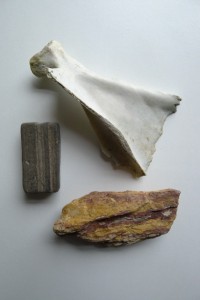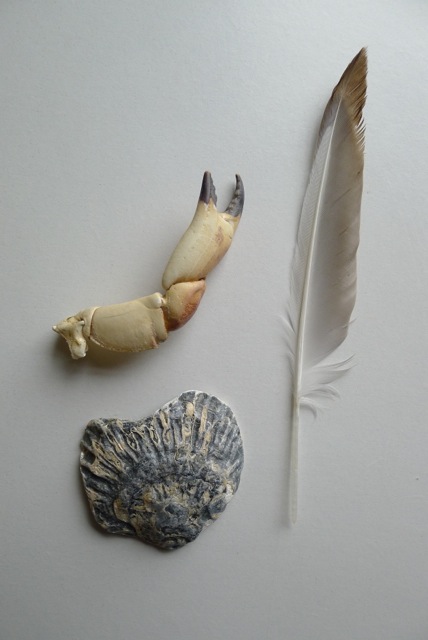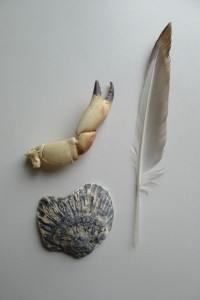WORDS: Jo Dacombe
Many of us collect things, picking up objects on a walk and taking them home. Why do we have a compulsion to do this?
For a while I’ve had a fascination with walking: why we walk, where we walk, how we walk. Something to do with how we relate to our environments. Picking up things is a part of this – which things do we notice, which things do we choose to pick up and take home?
A collection of objects found in your bag at the end of the walk say something about that walk, that place, that time, that experience. Each walk’s collection is unique and peculiar.
In contemporary art practice, and when I’m working in a gallery, we think a lot about objects. We employ deconstruction (developed by Jacques Derrida[i]), a postmodern way of thinking; reading objects (and art objects) as if they were texts, picking apart their meaning and how those meanings are constructed, how we interpret them according to their context and, indeed, our own contexts (what we bring to an interpretation from our own backgrounds). We think about “found things”, or objet trouvé – like when Marcel Duchamp put a bottle rack on a plinth[ii].
If we take an object and put it in a gallery, does this new context, and thus the way we now perceive it, make it art? And if we have taken, say, a dropped feather from a field on a walk and taken it home, and changed its context, have we changed its meaning?
What does it mean now that it “belongs” to my home?
Recently I’ve been developing a project with the University of Leicester within the School of Archaeology. This has come about as a result of my interest in picking up things, found things, objects that tell stories, as archaeological artefacts do. Archaeology is about bits of rubbish, remains and thrown away stuff. I’ve been introduced to Igor Kopytoff[iii] writing in “The social life of things”, proposing that we could think of things much as we do people, and construct biographies for these objects.
As with humans, objects have many biographies depending on the story you choose to tell. People have different biographies for their careers, their family lives, their travel histories. So do objects. They have economic value too, which can change according to their perceived status. (Just like humans.)
I turn these objects around in my hand and remember the walk where I picked them up. I remember the terrain, the weather, the time of day and season, the company. But the object doesn’t just take me back to the place I found it – it has its own innate meaning. I wonder what its story was – its biography. How did this stone come to wear a hole in it? Where does the rock come from, has it journeyed along million year old glacial routes to reach me?
Now it sits on my windowsill it has a new place, a place to be admired for its aesthetic value, perhaps.
These things are my everyday kinds of historical artefacts. They have a history of their own, they are a find that I can’t help trying to interpret, and they relate to the other collected objects to give a sense of the place where they were found. And now they are displayed, like artefacts in a museum, for us to admire and ponder over. Perhaps that is why we collect them, for they hold part of the mystery of the world and time within them.
Jo is an artist based in the East Midlands, interested in mapping, walking, objects, public space, layers of history, change and sense of place.
Visit her blog here. Follow Jo on Twitter here.
[i] Of Grammatology, Jacques Derrida, 1967 http://www.hudsoncress.net/hudsoncress.org/html/library/western-philosophy/Derrida,%20Jacques%20-%20Of%20Grammatology%20-%20chapter%202.pdf
[ii] Bottlerack, 1914. http://www.sfmoma.org/explore/multimedia/videos/144
[iii] Igor Kopytoff, 1986. – The cultural biography of things: commoditization as process. In Arjun Appadurai (ed.), The Social Life of Things: Commodities in Cultural Perspective. Cambridge University Press, Cambridge: 64–91.
http://www.english.upenn.edu/~cavitch/pdf-library/Kopytoff_CulturalBiography.pdf









